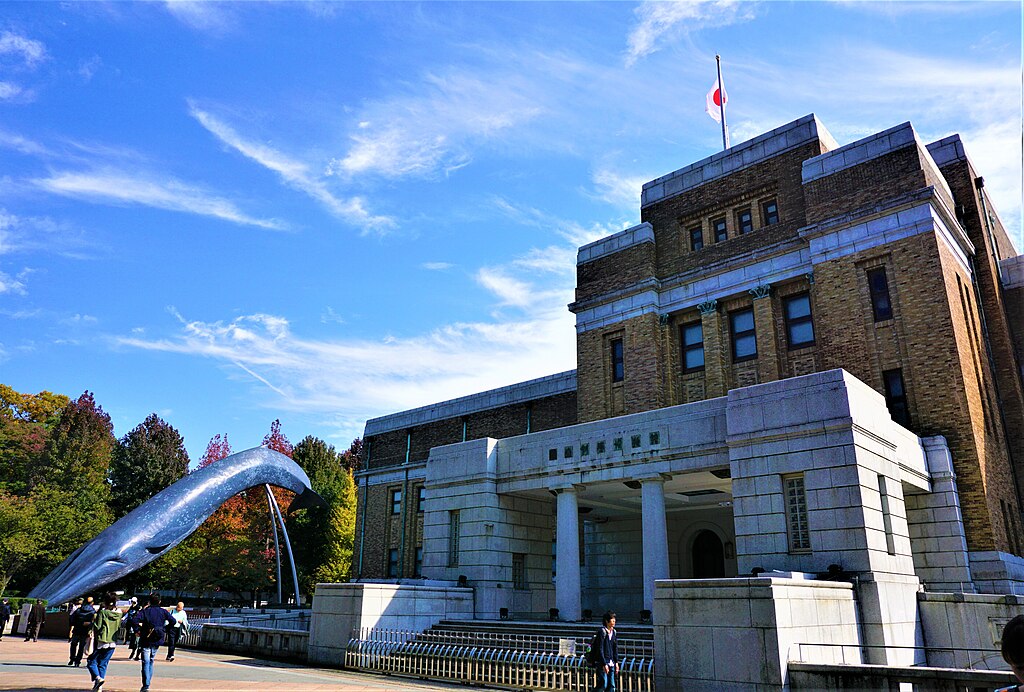
The National Museum of Nature and Science focuses on natural history exhibits and interactive scientific experiences. The museum also includes historical pre-Meiji science in Japan.
A Tour of National Museum of Nature and Science, Tokyo
- “Paleolithic Stone Tools from Hokkaido
- Troughton & Simms Astronomical Telescope
- Futabasaurus Suzuki
Highlights of National Museum of Nature and Science, Tokyo
Paleolithic Stone Tools from Hokkaido

These Stone Tools provide the evidence and dating for the first Homo sapiens in Japan, were made during the Japanese Paleolithic period that lasted from around 40,000 BCE to 14,000 BCE. The Paleolithic age is a prehistoric period of human history distinguished by the development of the most primitive stone tools.
These Stone Tools were found in Hokkaido, which is the second-largest island of Japan, located in the very north of Japan. It is believed that people first inhabited Hokkaido more than 30,000 years ago. Land bridges, created during glacial periods when the world sea level is lower, have periodically linked the Japanese archipelago to the Asian continent. Some of the first inhabited came from Siberia hunting food and game-like mammoths. Other early migrations came from southern regions via the Korean Peninsula or from southern islands. They all brought with them stone tool-making techniques and laid the foundation for Paleolithic culture in Hokkaido.
Chipped stone tools are made from cryptocrystalline stone materials. The process is a simple form of reduction by striking stone flakes from a core of material utilizing a hammerstone. Reducing the core to a rough unifacial or bifacial preform, which is then further reduced using soft hammer flaking techniques.
More complex forms of reduction can produce highly standardized blades, which can then be fashioned into a variety of tools such as scrapers, knives, sickles, and microliths. In general terms, chipped stone tools are nearly ubiquitous in all pre-metal-using societies because they are easily manufactured, the tool stone is usually plentiful, and they are easy to transport and sharpen.
Paleolithic Stone Tools from Hokkaido
- Title: Paleolithic Stone Tools from Hokkaido
- Material: Stone
- Created: 40,000 BCE to 14,000 BCE
- Discovered: Hokkaido, Japan
- Museum: National Museum of Nature and Science, Tokyo
Futabasaurus Suzuki

This Futabasaurus Suzuki is a reconstructed skeleton of the first-ever discovered fossil examples from the Plesiosaurs family found in Japan. The rocks in which it was found date to the early Santonian age of about 85 million years ago. Tadashi Suzuki found the fossils, a high school student, and the species name is derived from his family name, Suzuki.
About 70% of the fossil skeleton is preserved, and it is one of the most complete fossils discovered in Japan. It was exposed along the Ohisa River in Iwaki City, Fukushima.
Futabasaurus Suzuki
- Title: Futabasaurus Suzuki
- Material: Fossils
- Created: 40,000 BCE to 14,000 BCE
- Length: 6.4–9.2 meters (21–30 ft)
- Weight: 3–4 tonnes (3.0–3.9 LT)
- Discovered: Japan
- Museum: National Museum of Nature and Science, Tokyo
Troughton & Simms Astronomical Telescope

This Troughton & Simms Astronomical Telescope was the first astronomical telescope in Japan. It was imported from Britain in 1880 to be used in the Tokyo Astronomical Observatory and was used for observation and education. It is an equatorial refracting telescope with an aperture of 20cm. The body and mount are made of cast iron, and the movable parts are made of brass.
Troughton & Simms was a British instrument-making firm, which produced hundreds of astronomical instruments such as mural circles, transit circles, sextants, and other astronomical instruments for observatories around the world.
Troughton & Simms Astronomical Telescope
- Title: Troughton & Simms Astronomical Telescope
- Manufactured by: Troughton & Simms Ltd
- Date: 1800
- Aperture: 20cm
- Material: Iron, brass & glass
- Museum: National Museum of Nature and Science, Tokyo
- Name: National Museum of Nature and Science, Tokyo
- Japanese: 国立科学博物館
- Previous Names: Ministry of Education Museum, Tokyo Museum, Tokyo Science Museum, the National Science Museum of Japan
- City: Tokyo
- Country: Japan
- Opened: 1871
- Type: Nature and Science museum
- Location: 7-20 Uenokoen, Taitō, Japan
Explore Natural History Museums
- Natural History Museum, London
- American Museum of Natural History, New York
- National Museum of Natural History, Washington, D.C.
- Shanghai Natural History Museum
- National Museum of Nature and Science, Tokyo
Explore Science and Technology Museums
- Science Museum, London
- Queensland Museum & Science Centre
- National Museum of Nature and Science, Tokyo
- ArtScience Museum, Singapore
- Shanghai Science and Technology Museum
- Great Lakes Science Center, Cleveland
- Intrepid, Sea, Air & Space Museum, New York
- National Air and Space Museum, Washington DC
- National Museum of Nature and Science, Tokyo
Explore Maritime Museums
- Australian National Maritime Museum
- New Zealand Maritime Museum
- Queensland Maritime Museum
- WA Maritime Museum
- WA Shipwrecks Museum
- Intrepid, Sea, Air & Space Museum, New York
- USS Cod
~~~
“Giving birth to a baby is easier than worrying about it.”
– Japanese proverbs
~~~
Photo Credit: JOM
Popular this Week








 Sponsor your Favorite Page
Sponsor your Favorite Page SEARCH Search for: Search Follow UsJoin – The JOM Membership Program
Sponsor a Masterpiece with YOUR NAME CHOICE for $5
Share this:
- Tweet
